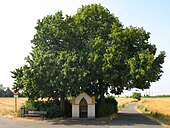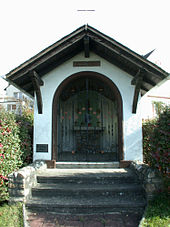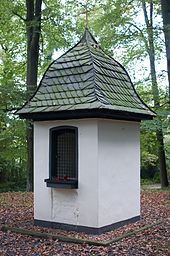Holy House

A saint's house is a small religious building designed to protect a saint figure or image placed in it . The houses are on streets and paths, in the open countryside or in the middle of town. You can often find them on pilgrimage and processional routes , regionally they are also called processional houses , altar or devotional houses or chapel shrines and counted among the wayside shrines.
function
Holy houses have always been a sign of piety and places of reflection. During processions they could serve as a stopover for the dispensing of the sacramental blessing , and during pilgrimages as a station . Often they were not donated by the general public, but by individual families, who thereby made their faith known in public. Nowadays the houses are looked after by the church, associations and the public sector as well as by private individuals, which often includes the constant renewal of flower arrangements and candlelights.
architecture
In the houses there is often an altar-like masonry substructure with a niche-like superstructure that houses the image of a saint , who is protected by latticework. The conclusion is roof-like. Larger saints' houses are also accessible and could serve as a shelter for shelter in the rain, sometimes attached canopies were also used for this purpose.
Sometimes holy houses are provided with an offering box and a candlestick for offering candles . More common are also found next to the Heiligenhäuschen benches made of wood or, especially in iTaste Eifel , from basalt as a seat, in some regions and higher stone pillar or wooden stands (in the Rhineland Räst called), on which one loads (eg. As baskets of market goods ) so that you don't have to pick it up from the ground after the rest.
history
Holy houses can be traced from the early 13th century to the 20th century. The buildings were created from different motifs. In addition to the veneration of the saints depicted - often Mary , the Mother of God - they were erected earlier to commemorate special occurrences or terrible events such as accidents or epidemics or to protect fields and farms. Some mark special points in the landscape, represent the fulfillment of vows ex voto or are simply an expression of faith. Many are associated with legends that are often considered "ancient", but in many cases can actually only be traced back to the romantic era.
Younger story
Especially after the Second World War, many holy houses were demolished for traffic reasons, land consolidation measures or large-scale mining of natural resources (e.g. lignite or pumice ). Sometimes they were replaced by modern buildings or rebuilt in other places true to the original. For security reasons (risk of theft), valuable sculptures or paintings had to be brought to better-secured churches or museums in many of the originally preserved holy houses. Historically significant holy houses are now protected as monuments because of their art, culture and local history .
literature
- Hildegard Feltgen, Gerhard Feltgen: Witnesses on the way. Holy houses and hall crosses. Mercator-Verlag, Duisburg 1989, ISBN 3-87463-154-0 .
- Hatto Küffner, Edmund Spohr : Monuments in Düsseldorf. Volume 1: Crosses, chapels, holy houses. Cultural Office, Düsseldorf 1985.
- W. Peters: Brilon Holy House. In: Heimwacht. Vol. 10, No. 1, 1928, ZDB -ID 208490-9 , pp. 16-18 digital copy (PDF; 13.68 MB).
- Heinz Schüler: Crosses and holy houses in the Koblenz district. Görres, Koblenz 1977.
- Reinhold Weber, Alfred Bruns: Architectural and art monuments of the city of Schmallenberg. Volume 2: Churches, chapels, wayside crosses, holy houses and wayside shrines. Westphalian Slate Mining and Local History Museum, among others, Schmallenberg-Holthausen among others 2002, ISBN 3-930264-42-0 .
Web links
Individual evidence
- ↑ ( Page no longer available , search in web archives: Blessing of a renovated altar house in Saal (Lower Franconia) )
- ↑ ( Page no longer available , search in web archives: Guide to the small and land monument database for Lower Austria and Salzburg ), Category 1520–1540, accessed on September 10, 2012
- ↑ suehnekreuz.de , based on: Elke Lehmann-Brauns: Heaven, Hell, Pest and Wolves. Basalt lava crosses of the Eifel. Bachem Verlag, Cologne 1986, ISBN 3-7616-0852-7 , p. 38.
- ^ Friedrich Zoepfl : wayside shrine . In: Real Lexicon on German Art History . Volume 2: Bauer - Illumination. Druckmüller, Stuttgart 1948, Sp. 695-707, especially Sp. 703.

